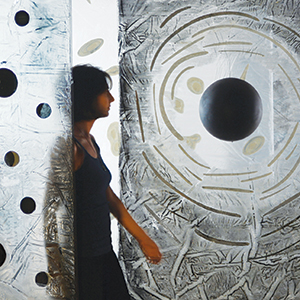Arts
Finding the Art In Our Stars
 The work of self-made astronomer and artist Russell Crotty is on display at 'Look Back in Time.'
The work of self-made astronomer and artist Russell Crotty is on display at 'Look Back in Time.'
For some of us, looking up and out into the depths of space is as unsettling as, say, swimming alongside a blue whale. There's something about the infinity that can make a body feel small. But that's not the case for artist Russell Crotty.
Marking the end of his two-year residency at the Institute of the Arts and Sciences at UC Santa Cruz, the San Jose Institute of Contemporary Art is presenting a solo exhibition of Crotty's work.
With Look Back in Time—a collaboration between the IAS, the ICA and the Lick Observatory—Crotty, a self-made astronomer, presents us with a beautiful interpretation of the stars.
The title refers both to the concept of "lookback time"—that the light we see travelling in our telescopes is from the past—and the historical objects on display from the Lick, which opened in 1888. According to Cathy Kimball, ICA's executive director, Look Back was an opportunity, "not only to contextualize Crotty's work, but to really bring it more to life so that you better understand where Russell has come from in his passion and study of astronomy and how in-depth it is."
She also described it as a site-specific immersive installation. Kimball added, "On a clear day, we can all see (Lick from the ICA), but nobody really knows what's in there. I love having objects here from the 1880s, and that they're as important for contemporary conversations as they ever were." The Lick component fit into place due in part to a conversation between IAS Director John Weber and Tony Misch, a resident astronomer on Mt. Hamilton, who started The Lick Observatory Historical Collection.
Misch's approach to organizing the 100-plus years of artifacts was two-fold: "Nothing that's on display can be seen at Lick, it's all hidden away in the archives. My attraction to these things was visual as well as historic. My dream has always been to show them in an art context." This exhibit, he says, was a dream come true. The Lick objects on display include photographic glass plates, scientific instruments and handwritten materials. Housed in a gallery room next to Crotty's work, it's easy to see the links between his finely wrought drawings and the 19th century notebooks full of minute etchings and scrawls.
Crotty's work comes from direct observations he has made through his telescopes—all filtered through his imagination. He described the process of his residency like this: "Go to the observatory, do the thumbnails, take them back to the studio, make something." And make something he did, many somethings. Hanging from the rafters are globes, asteroids and "blue blobs." These blobs, painted sky blue and cloud white, are shaped like the bodies of anonymous water birds. They represent those parts of the sky that can't be identified.
The gallery that focuses solely on Crotty's work is arranged by a chart of the current universe, a history of everything, that goes back in time as far they can go. "They" being UC astronomers and astrophysicists, like Dr. Garth Illingworth, who Crotty spent time with over the last two years. Weber would take him to drop-ins with different scientists in order to talk about what they were working on. But Crotty also found inspiration from astronomers like Edward Emerson Barnard, who joined the Lick Observatory in 1887. Crotty pointed out that, "Barnard was the first to photograph the Milky Way with wide field cameras. He found these dark nebulae against these star clouds, towards the center of our galaxy and Sagittarius." Crotty repurposed those dark objects into drawings that are nods to the photographs but represent his vision of the stars.
And in case you're thinking of venturing up into space, Crotty has also drawn out an atlas of the sky on enormous pads of paper and architectural film. He likened some of the pages to the work of Alighiero Boetti, but his fanciful drawings map the constellations of the Northern Hemisphere.
Crotty talked briefly about the origins of his celestial interests. He was looking through a telescope borrowed from his junior high school: "Jupiter was rising over the bay in San Rafael. The color, the subtlety. If you ever see Saturn, you'll think someone taped a photo inside the telescope. It's so crisp, and hard to describe." For just a moment, he was looking back in time and retrieved something as fleeting as a comet racing away from him and into the past.
Look Back in Time
Nov 13-Feb 26, Free
San Jose Institute of Contemporary Art


